May 18, 2025 | 06:26 GMT +7
May 18, 2025 | 06:26 GMT +7
Hotline: 0913.378.918
May 18, 2025 | 06:26 GMT +7
Hotline: 0913.378.918
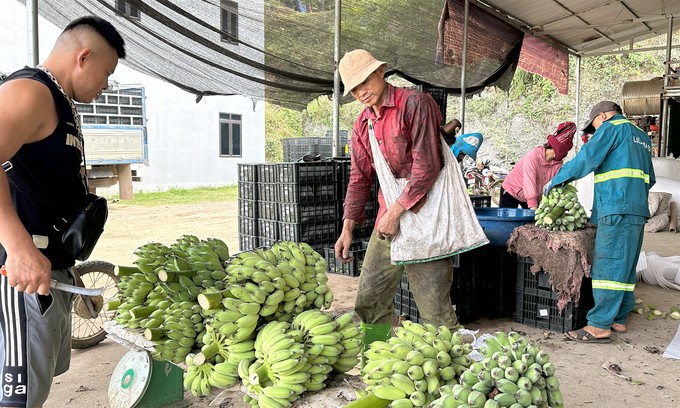
Son La Mac Phi Banana Cooperative enters the harvest crop. Photo: Duc Binh.
As a cluster-rooted plant with the ability to penetrate less deeply than tap-rooted plants, bananas are very afraid of the soil with erosion, waterlogging, or hard rocks. The whole country has many large banana granaries, grown most commonly on alluvial soil, sandy soil, or light loam soil.
This shows that the journey to bring banana trees to the sloping land of Son La is not easy. Dr. Tran Danh Suu, Vietnam Seed Association, admitted that with sloping terrain less than 8°, people should plant bananas in rows of crocodile fangs (in rows but staggered) to limit soil erosion. If the slope is greater than 8°, it is required to design contour lines with a surface of 3-4 m depending on the slope. In particular, bananas should not be grown in places with slopes greater than 30°.
According to Mr. Suu, people should base banana varieties to decide planting density. Varieties with shorter trees and narrow foliage, such as dwarf Cavendish bananas and king bananas, can be planted thickly, while varieties such as medium-height Cavendish bananas, tall Cavendish bananas, etc., should be planted more sparsely. Common planting density is about 1,000 trees/ha, with a distance of 3x3m or 3x2.5m. However, if planting at high density, it is necessary to choose uniform seedlings to avoid the phenomenon of encroachment and competition for nutrients and light between plants.
"Properly thick planting has a good effect on the banana garden. The garden will soon be shaded, have fewer weeds, create hot and humid conditions suitable for banana trees, and best of all, increase banana productivity," Mr. Suu analyzed.
Bananas need a lot of water during the growing process. Therefore, in Son La, people must design a reasonable irrigation and drainage system. Depending on conditions, an economical irrigation system or surface irrigation can be arranged. For newly planted gardens with a large area, it is necessary to plan on-farm roads to transport materials, fertilizers, and harvested products by motorized vehicles.
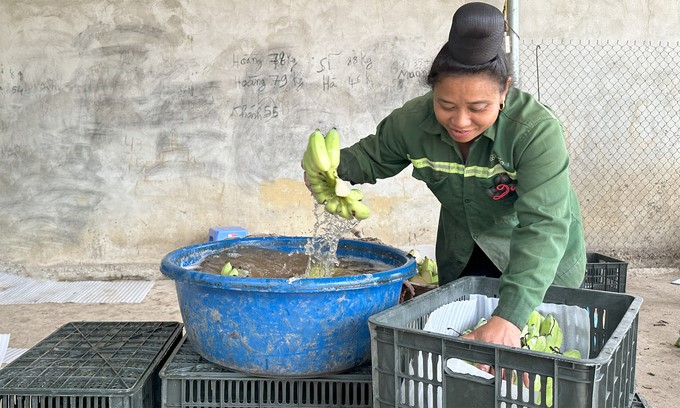
Banana trees help many households in Muong La change their lives. Photo: Duc Binh.
Throughout the life of the tree, soil humidity needs to be regularly maintained at 60–70%. Besides, banana trees (especially Cavendish bananas) grow best in places with evenly distributed rainfall of about 200–220 mm/month. This is also the basis for forming large-scale specialized farming areas oriented towards export.
Based on this characteristic, bananas should be planted at the beginning of the rainy season, from around the end of April to August. If the banana variety is from tissue culture, farmers can tear the seedling bag, loosen the soil, and place the seedling in the hole, fill it with soil, and water it thoroughly so that the roots and soil are in close contact with each other. For trees grown in buds, it is also necessary to water them thoroughly so that the tree stump and the soil are in close contact with each other.
Until harvest, bananas need to be fertilized about 6–8 times, of which the first fertilization is right after planting for about 15 days or after harvest. The last fertilization is 2 months before the expected harvest. The way to fertilize is to dig shallow furrows in a circle, 30–60 cm from the stump, then spread fertilizer and cover with soil. It is noted that watering after fertilizing will increase the effectiveness of the fertilizer, helping the roots spread quickly.
According to Dr. Tran Danh Suu, an important stage to improve the survival rate and revive the tree quickly is to compact the banana stump so that the tree does not get shaken by the wind, causing the tree to fall and break young roots, and to create conditions for the tree to closely contact the soil to facilitate rooting. Pay attention to compacting the soil, but do not compact the soil tightly against the fake trunk. This can easily cause the sheath of the fake trunk to be pressed tightly, and the growth point cannot develop. If the soil is dry, people should compact the soil parallel to the fake trunk or use their feet to stamp it firmly and then water.
Currently, specialized agencies recommend that people propagate bananas by tissue culture. Although this method requires high techniques and complex operations, it has the advantages of a high propagation coefficient; creating a large number of seedlings to supply production; disease-free and healthy seedlings; and seedlings having high uniformity and similar growth and development capabilities when planted. Banana gardens grown from tissue culture varieties will yield simultaneous harvests, meeting the raw material sources in both quantity and quality.
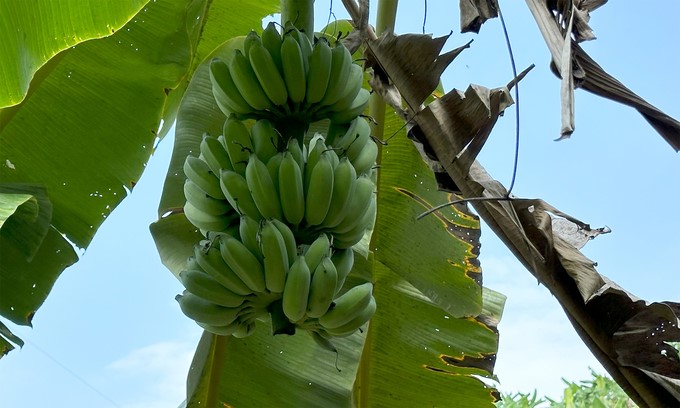
If the price is good, exported bananas can be sold for up to VND 10,000/kg. Photo: Duc Binh.
In Muong La, a remote district of Son La province, banana trees have helped Son La Mac Phi Banana Cooperative in Muong Bu commune "change the meat." Since 2023, when the Chinese market reopened with great demand, the Cooperative has expanded its area to 10 hectares. On average, each month, the Cooperative harvests about 300 tons of bananas, possibly increasing to 700 tons during the peak season.
On average, each hectare of bananas yields 0.7–1 ton/harvest time, with the selling price to China ranging from VND 6,000 to VND 7,000/kg. If exported to South Korea or Japan, the price can be up to VND 10,000/kg. After deducting expenses, each cooperative member earns a profit of VND 200–300 million/year, while affiliated households also achieve an income of VND 70–100 million/year.
Not satisfied with this result, Mac Phi Cooperative hopes to link with more households in Muong Bu commune. Director Quang Van Phi calculated that if tissue culture varieties could be widely used, any household growing 3 hectares or more would be able to earn an income of billions each year.
Để có ngày hôm nay, ngoài việc đào tạo, tập huấn cho thành viên HTX tuân thủ nghiêm ngặt quy trình canh tác, vị giám đốc HTX đặc biệt lưu ý đến thời điểm thu hoạch. Cụ thể, khoảng thời gian từ lúc trổ buồng đến thu hoạch dao động khoảng 3 - 4 tháng.
To have today, in addition to training cooperative members to strictly follow the farming process, the Director of the Cooperative paid special attention to harvest time. Specifically, the time from flowering to harvest ranges from 3 to 4 months.
Based on fruit color or plumpness, bananas will be harvested when they are about 75-80% ripe; their skin is still light green, slightly rounded; and the flesh is ivory white. For on-site or domestic consumption, bananas can be left to ripen to 85–90% when the skin turns yellow-green and the flesh turns yellow.
Harvest should be done in a dry time, when it is not rainy and not too hot. Mr. Phi added that after harvest and during transportation to the processing and packaging area, banana bunches need to be placed on soft pads to avoid scratching the fruit skin.
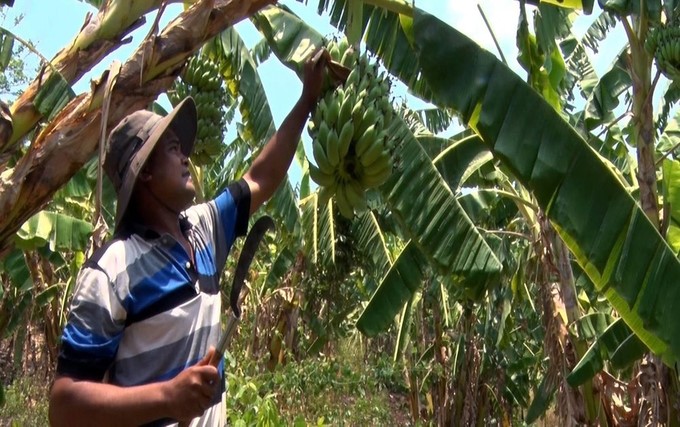
Bananas need a lot of water during their growing period. Photo: Duc Binh.
For export, it is necessary to use a sharp knife to cut each hand and cut the stalk very short before dipping in the active ingredient Thiophanate-methyl to prevent fungal diseases that cause fruit rot. Drain the water and fruit sap, then place in a plastic basket, wooden basket, or carton box. Finally, the bananas are kept in cold storage, with temperatures of 13–15°C.
Currently, Mac Phi Cooperative, as well as many other banana export cooperatives in Son La, have thoroughly applied good agricultural practices, including regular field cleaning to destroy germs and shelters of pests.
In addition to common diseases such as Sigatoka disease, Anthracnose disease, etc., Director Quang Van Phi is so concerned about Panama disease. The disease can occur at any stage of plant growth. Old leaves turn yellow first, then gradually spread to the top leaves. There have been many banana areas "suffering" from this Panama disease. Therefore, Mr. Phi always encourages members of the Cooperative to closely monitor the fields to promptly have a treatment plan if pathogens appear.
Translated by Thu Huyen

(VAN) 14 out of 35 domesticated elephants in Dak Lak province have had their living conditions improved, with 11 of them currently participating in the non-riding elephant tourism model.

(VAN) Muong Nhe Nature Reserve hopes that being upgraded to a national park will lay the foundation for forest protection efforts to be carried out in a systematic, modern, and sustainable manner.
/2025/05/16/3923-2-171845_52.jpg)
(VAN) Lower costs, higher yields, and improved soil quality are outstanding benefits that soybeans bring when integrated into the crop rotation system.
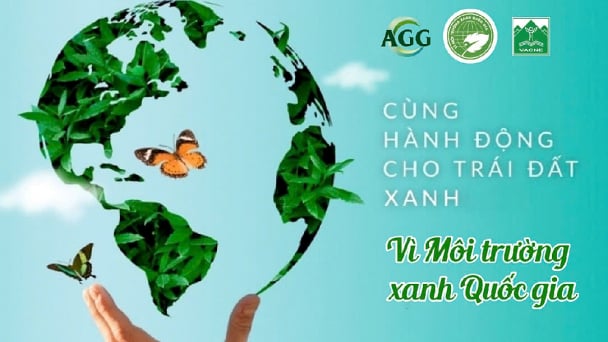
(VAN) The 'For a Green National Environment' programme aims to promote a green lifestyle, support businesses in implementing ESG practices, and turn Net Zero commitments into concrete actions.

(VAN) Cold-barn systems efficiently manage environmental and temperature conditions, which aids in the prevention of respiratory diseases in pigs and protects them from the vectors that transmit African swine fevers.

(VAN) To tackle challenges, the project 'Addressing key technical bottlenecks in the grouper supply chain in Vietnam' has been underway since 2024.

(VAN) The project 'Disease-Resilient and Sustainable Cassava Production Systems in the Mekong Region', funded by the Australian Center for International Agricultural Research (ACIAR), is being implemented from 2024 to 2028.